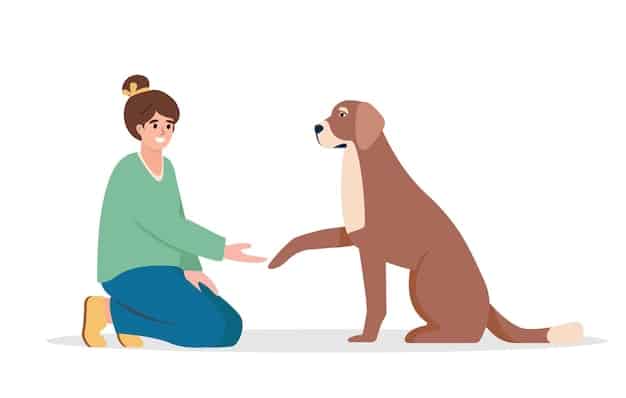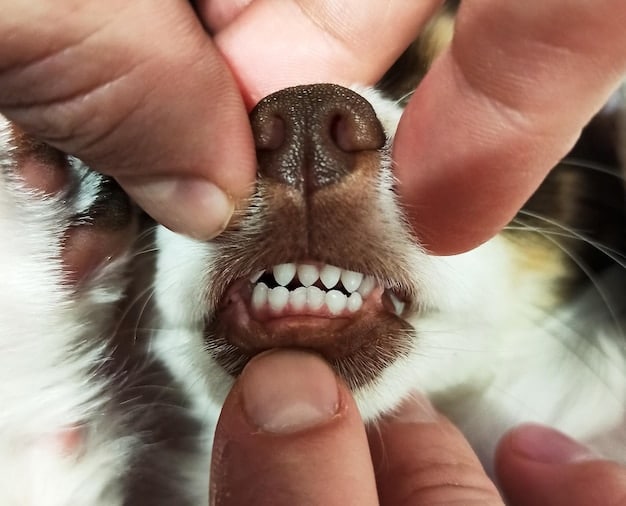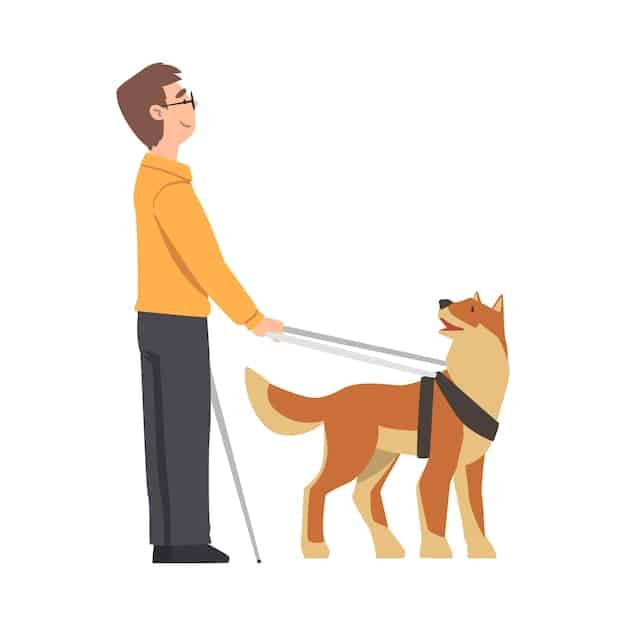Emergency First Aid for Pets: CPR, Bleeding, and Choking

Emergency first aid for pets involves knowing how to handle critical situations like CPR, bleeding control, and choking until you can reach veterinary care, potentially saving your pet’s life.
Discover essential emergency first aid: What to do before you get to the vet (CPR, bleeding, choking), equipping you with the knowledge to act swiftly and effectively in critical situations, potentially saving your beloved pet’s life.
Recognizing a Pet Emergency
Identifying when your pet is facing a true emergency is the first crucial step in providing effective aid. Knowing the signs and symptoms that warrant immediate intervention can significantly impact your pet’s chances of survival and recovery.
Quick recognition allows you to act fast.
Critical Signs and Symptoms
Several key indicators signal a pet emergency. Recognizing these signs promptly can make a significant difference.
- Difficulty Breathing: Gasping, labored breathing, or blue-tinged gums are critical signs.
- Severe Bleeding: Uncontrolled bleeding from any part of the body requires immediate attention.
- Loss of Consciousness: Unresponsiveness or fainting spells should never be ignored.
- Seizures: Sudden, uncontrolled shaking or jerking movements indicate a serious issue.

Promptly recognizing these signs and contacting your veterinarian are critical aspects of emergency care, providing better odds of recovery.
Pet CPR (Cardiopulmonary Resuscitation)
CPR is a life-saving technique that can help revive your pet when they have stopped breathing or their heart has stopped. Knowing how to perform CPR correctly can be the difference between life and death in critical situations.
CPR involves chest compressions and artificial respiration.
How to Perform Pet CPR
Performing CPR on your pet requires a systematic approach. Here’s a step-by-step guide to help you through the process:
- Check for Responsiveness: Gently shake your pet and call their name to see if they respond.
- Clear the Airway: Open your pet’s mouth and check for any obstructions. Remove any visible objects carefully.
- Give Rescue Breaths: Close your pet’s mouth and cover their nose with your mouth, giving gentle breaths. Watch for the chest to rise.
- Perform Chest Compressions: Place your hands on the chest and compress firmly. The rate and depth vary based on the pet’s size.
Mastering these steps can provide your loved one with the chance to return from the brink in a life threatening situation.
Controlling Bleeding in Pets
Severe bleeding can quickly become life-threatening for pets. Knowing how to control bleeding effectively can buy you valuable time as you transport your pet to veterinary care. Prompt action can significantly reduce the risk of complications.
Apply direct pressure to the wound.
Techniques for Controlling Bleeding
Several techniques can help control bleeding effectively. These methods will help stabilize your pet until professional help is available:
- Apply Direct Pressure: Use a clean cloth to apply firm pressure to the wound.
- Elevate the Wound: If possible, elevate the injured area to help reduce blood flow.
- Use a Tourniquet: As a last resort, apply a tourniquet above the wound to restrict blood flow.
By mastering these techniques, you can effectively stabilize your pet and prevent further complications.
Helping a Choking Pet
Choking is a frightening emergency that can quickly lead to suffocation in pets. Knowing how to dislodge an object from your pet’s airway can be life-saving. Fast and correct intervention is crucial to prevent severe consequences.
Perform the Heimlich maneuver.
Steps to Help a Choking Pet
If your pet is choking, act quickly using some of the following steps:
- Assess the Situation: Look for signs of choking, such as gagging, coughing, or difficulty breathing.
- Check the Mouth: Open your pet’s mouth and look for visible obstructions. Remove any objects if possible.
- Perform the Heimlich Maneuver: Depending on the size of your pet, use abdominal thrusts or chest compressions to dislodge the object.

Knowing these immediate techniques, can help you save your pet’s life when every second counts. By acting swiftly and correctly, you can ensure that your pet has the best chance of survival.
Assembling a Pet First Aid Kit
Having a well-stocked pet first aid kit is essential for handling emergencies. A comprehensive kit ensures that you have the necessary supplies on hand to address various injuries and medical conditions. Proper preparation can make a significant difference when immediate care is needed.
Include essential medical supplies.
Essential Items for a Pet First Aid Kit
A complete pet first aid kit should include several key items. Here’s a checklist to help you assemble your kit:
- Bandages: Include various sizes of bandages to cover wounds and control bleeding.
- Antiseptic Wipes: Use these to clean wounds and prevent infection.
- Tweezers: Helpful for removing splinters, ticks, or other foreign objects.
- Emergency Contact Information: Keep your veterinarian’s and local emergency animal hospital’s contact details handy.
A good kit helps provide the best immediate care for unexpected problems.
Preventing Pet Emergencies
Prevention is always better than cure when it comes to pet emergencies. Taking proactive steps to protect your pet from common hazards can reduce the likelihood of serious injuries. Creating a safe environment minimizes the need for emergency interventions.
Secure hazardous materials at home.
Tips for Preventing Emergencies
There are several steps you can take to prevent pet emergencies. Implementing these practices can safeguard your pet’s health and well-being.
- Secure Hazardous Materials: Keep cleaning supplies, medications, and other toxins out of reach.
- Supervise Outdoor Activities: Monitor your pet during walks and playtime to prevent accidents.
- Regular Veterinary Check-ups: Routine examinations can identify and address potential health issues early.
- Pet-Proof Your Home: Secure loose electrical cords, sharp objects, and other hazards.
By implementing these preventative measures, you create a protected environment to preserve your furry friend’s well-being.
| Key Point | Brief Description |
|---|---|
| 🫀 CPR | Technique to revive pets with no heartbeat. |
| 🩸 Bleeding Control | Apply direct pressure; elevate the wound. |
| 😮💨 Choking Aid | Perform the Heimlich maneuver for pets. |
| 🩹 First Aid Kit | Essential supplies for immediate pet care. |
Frequently Asked Questions (FAQ)
▼
To check your pet’s pulse, place two fingers on the inner thigh near the groin area. Count the number of beats for 15 seconds and multiply by four to get the beats per minute.
▼
If you suspect your pet has been poisoned, immediately contact your veterinarian or the ASPCA Animal Poison Control Center. Provide details about the substance ingested and follow their instructions.
▼
You should check your pet’s first aid kit at least every six months to ensure all items are in good condition and not expired. Replenish any used or outdated supplies promptly.
▼
The normal breathing rate for a dog is typically 12-24 breaths per minute, while for a cat, it is usually 20-30 breaths per minute. These rates can vary based on age, breed, and overall health.
▼
To prevent your pet from choking, avoid giving them small toys or bones that can be easily swallowed. Supervise their playtime and eating habits, and ensure they cannot access hazardous objects.
Conclusion
Equipping yourself with knowledge to provide emergency first aid: What to do before you get to the vet (CPR, bleeding, choking) can be a game-changer for your pet’s life. Prepare a first-aid kit, know techniques like CPR, bleeding control, and anti-choking maneuvers, and keep your home safe to handle those critical situations before veterinary assistance arrives.





